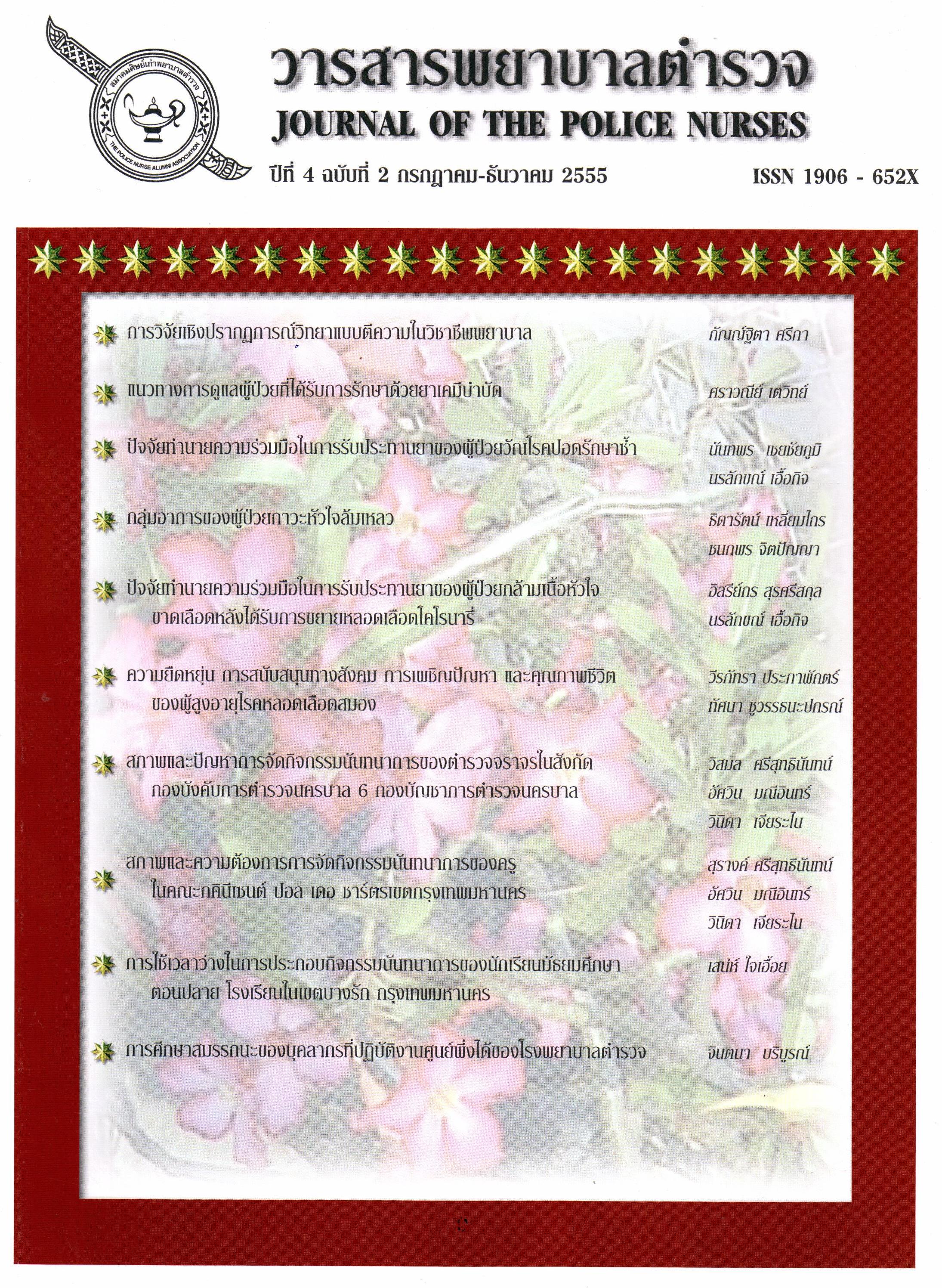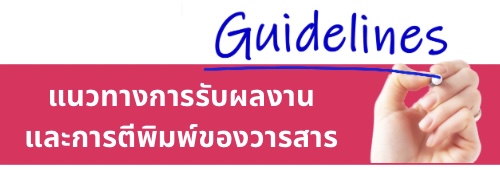ปัจจัยทำนายความร่วมมือในการรับประทานยาของผู้ป่วยวัณโรคปอดรักษาซ้ำ
คำสำคัญ:
ปัจจัยทำนาย, ความร่วมมือในการรับประทานยา, ผู้ป่วยวัณโรคปอดรักษาซ้ำ, Predicting factors, Medication adherence, treatment patients, pulmonary tuberculosisบทคัดย่อ
บทคัดย่อ
การวิจัยนี้เป็นการศึกษาความสัมพันธ์เชิงทำนาย มีวัตถุประสงค์เพื่อศึกษาความร่วมมือในการรับประทานยาและอำนาจทำนายของปัจจัยทำนาย ได้แก่ การรับรู้ประโยชน์ในการรับประทานยา การรับรู้ความรุนแรงของโรค การรับรู้อุปสรรคในการรับประทานยา การรับรู้ตราบาป ภาวะโรคร่วมและการสนับสนุนทางสังคมกับความร่วมมือในการรับประทานยาของผู้ป่วยวัณโรคปอดรักษาซ้ำ ตัวอย่างคือ ผู้ป่วยวัณโรคปอดรักษาซ้ำวัยผู้ใหญ่ โดยการสุ่มหลายขั้นตอน จำนวน 132 คน ที่มารับบริการที่คลินิกวัณโรค สถาบันโรคทรวงอกโรงพยาบาลพระมงกุฏเกล้า และคณะแพทยศาสตร์วชิรพยาบาล มหาวิทยาลัยกรุงเทพมหานคร เครื่องมือที่ใช้ ได้แก่ แบบสอบถามข้อมูลส่วนบุคคลและภาวะโรคร่วม ความร่วมมือในการรับประทานยา การรับรู้ประโยชน์ในการรับประทานยา การรับรู้ความรุนแรงของโรค การรับรู้อุปสรรคในการรับประทานยา การรับรู้ตราบาปและการสนับสนุนทางสังคม วิเคราะห์ข้อมูลโดยใช้ ความถี่ ร้อยละ ค่าเฉลี่ย ส่วนเบี่ยงเบนมาตรฐาน และสถิติการวิเคราะห์ถดถอยพหุคูณ
ผลการวิจัยสรุปได้ดังนี้
- ผู้ป่วยวัณโรคปอดรักษาซ้ำมีความร่วมมือในการรักษาอยู่ในระดับสูง (
= 25.36, SD = 2.57)
- การรับรู้ประโยชน์ในการรับประทานยา การสนับสนุนทางสังคม และการรับรู้ความรุนแรงของโรค มีความสัมพันธ์ทางบวกกับความร่วมมือในการรับประทานยาของผู้ป่วยวัณโรคปอดรักษาซ้ำ (r = .774, .707 และ .604 ตามลำดับ) การรับรู้อุปสรรคในการรับประทานยาและภาวะโรคร่วม มีความสัมพันธ์ทางลบกับความร่วมมือในการรับประทานยาของผู้ป่วยวัณโรคปอดรักษาซ้ำ (r = -.522 และ -.328) อย่างมีนัยสำคัญทางสถิติที่ระดับ .05
- การรับรู้ประโยชน์ในการรับประทานยา การรับรู้ความรุนแรงของโรค การรับรู้อุปสรรคในการรับประทานยา การรับรู้ตราบาป ภาวะโรคร่วมและการสนับสนุนทางสังคม สามารถร่วมทำนายความร่วมมือในการรับประทานยาของผู้ป่วยวัณโรคปอดรักษาซ้ำได้ ร้อยละ 78.1 (R2 = .781, p < .05)
Predicting Factors of Medication Adherence among Retreatment Patient’s with Pulmonary Tuberculosos
Abstract
The purposes of this predictive correlational research were to study medication adherence to regimens and to examine the predictability of predicting factors; perceived benefits to medication, perceived severity, perceived barriers to medication, comorbidity, stigma and social support of medication adherence to regimens among retreatment patients with pulmonary tuberculosis. 132 among retreatment patients with pulmonary tuberculosis selected by multi-stage random sampling, who visiting TB clinics in Central Chest Institute, Phramongkutklao Hospital, and Faculty of Medicine Vajira Hospital University of Bangkok Metropolis. Questionnaires were composed of demographic information and comorbidity, medication adherence to regimens, perceived benefits to medication, perceived severity, perceived barriers to medication, stigma and social support questionnaires. Descriptive statistics (e.g., percent, mean, and standard deviation), and Multiple regression were used in statistical analysis.
The major findings were as follows:
- Mean score of medication adherence to regimens among retreatment patients with pulmonary tuberculosis was at a good level (
= 25.36 , SD = 2.57).
- Perceived benefits to medication, social support, and perceived severity were positively related to medication adherence to regimens among retreatment patients with pulmonary tuberculosis (r = .774, .707, and .604, respectively,. p < .05). Perceived barriers to medication and comorbidity were negatively related to medication adherence to regimens of among retreatment patients with pulmonary tuberculosis (r = -.522 and-.328, p < .05).
- Perceived benefits to medication, perceived severity, perceived barriers to medication stigma, comorbidity and social support increase the explained variance in medication adherence. Variables accounted for 78.1 % of total variance in medication adherence. (R2 = .781, p < .05).
Downloads
ดาวน์โหลด
รูปแบบการอ้างอิง
ฉบับ
ประเภทบทความ
สัญญาอนุญาต
ผลงานที่ได้ตีพิมพ์แล้วจะเป็นลิขสิทธิ์ของวารสารพยาบาลตำรวจ















